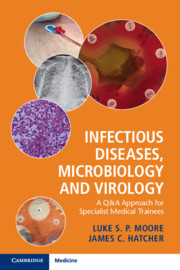Book contents
- Infectious Diseases, Microbiology and Virology
- Infectious Diseases, Microbiology and Virology
- Copyright page
- Contents
- Preface
- Reference Ranges
- Abbreviations
- Chapter 1 Biology of Bacteria, Viruses, Fungi and Parasites and the Host–Pathogen Interactions
- Chapter 2 Microbiology and Virology Laboratory Practice
- Chapter 3 Health and Safety for Infectious Diseases, Microbiology and Virology
- Chapter 4 Principles of Public Health in Relation to Infectious Diseases, Microbiology and Virology
- Chapter 5 Infection Prevention and Control
- Chapter 6 Important Clinical Syndromes Presenting from the Community and within Healthcare Organisations
- Chapter 7 Understanding the Use of Antimicrobial Agents
- Chapter 8 Vaccination
- Chapter 9 The Management of HIV Infection, Opportunistic Infections and Complications of Other Causes of Immunocompromise
- Chapter 10 Travel and Geographical Health; Imported Infection and the Provision of Pre-travel Health Advice
- Index
- References
Chapter 1 - Biology of Bacteria, Viruses, Fungi and Parasites and the Host–Pathogen Interactions
Published online by Cambridge University Press: 19 December 2019
- Infectious Diseases, Microbiology and Virology
- Infectious Diseases, Microbiology and Virology
- Copyright page
- Contents
- Preface
- Reference Ranges
- Abbreviations
- Chapter 1 Biology of Bacteria, Viruses, Fungi and Parasites and the Host–Pathogen Interactions
- Chapter 2 Microbiology and Virology Laboratory Practice
- Chapter 3 Health and Safety for Infectious Diseases, Microbiology and Virology
- Chapter 4 Principles of Public Health in Relation to Infectious Diseases, Microbiology and Virology
- Chapter 5 Infection Prevention and Control
- Chapter 6 Important Clinical Syndromes Presenting from the Community and within Healthcare Organisations
- Chapter 7 Understanding the Use of Antimicrobial Agents
- Chapter 8 Vaccination
- Chapter 9 The Management of HIV Infection, Opportunistic Infections and Complications of Other Causes of Immunocompromise
- Chapter 10 Travel and Geographical Health; Imported Infection and the Provision of Pre-travel Health Advice
- Index
- References
Summary
Microbial and host cellular biology and interactions dictate the breadth of clinical infection practice, from colonisation to invasion to infection. Understanding the classifications used for bacteria, viruses, fungi and parasites aids clinical and laboratory diagnosis and ultimately patient management. Understanding the common host responses to infective agents at the cellular level enables appropriate clinical management both with direct acting anti-infectives and other supportive therapy.
- Type
- Chapter
- Information
- Infectious Diseases, Microbiology and VirologyA Q&A Approach for Specialist Medical Trainees, pp. 1 - 23Publisher: Cambridge University PressPrint publication year: 2019



